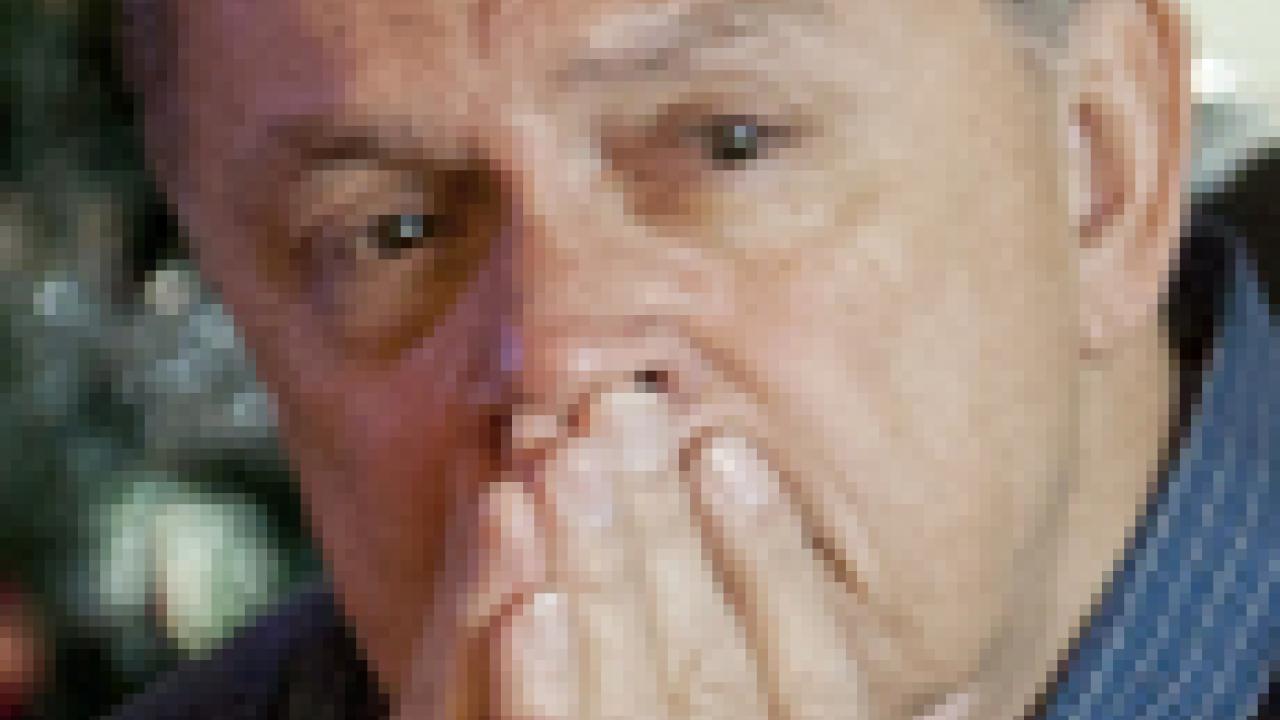With outstretched arms, Gary Colberg pointed to the two men seated on opposite ends of the couch across from him, exclaiming with a grin:
“Now I know why I hurt so much, between the two of you guys doing all that pounding on my chest!”
Yes, it hurt, Colberg said, more than anything he had endured playing Division I football at the University of Minnesota. But he also acknowledged what the pounding of cardiopulmonary resuscitation had accomplished: “That’s what saved me, for sure.”
“I’m just so grateful,” Colberg said Jan. 4 during his first reunion with three bystanders who came to his aid the morning of Dec. 22 when he collapsed on a treadmill in the fitness room at the Activities and Recreation Center.
“You’re welcome, so are we!” said UC Davis alumna Leslie Whiteford, a Davis schoolteacher. She joined fellow rescuers Mike Molina, another alum, and Nelson Randolph, a UC Davis employee, on a visit to see Colberg and his family at their Davis home, where he has been recuperating since his discharge Dec. 27 from Sutter Memorial Hospital in Sacramento. Colberg, 69, was treated for arrhythmia, an irregular heartbeat.
See separate story for details on the rescue, and how Colberg is doing today.
Colberg said he does not have any memory of his collapse. Other people have filled him in, and, at this week’s emotional reunion, he heard from the people who got to him first — the ones who pulled him out from amid the treadmills, started CPR and shocked him with an automated external defibrillator.
“After hearing all that, I can’t believe everything worked out,” Colberg said.
In fact, said Molina, a physician with Sutter Health’s Family Practice Residence Program in Sacramento, “It really was a miracle. People don’t usually come back from that.” He told Colberg: “You were out, you had no pulse.”
Good compressions, great courage
Even his fellow physicians are amazed by the story, Molina said.
Molina and Whiteford started CPR almost immediately, and Randolph jumped in to relieve Molina while he hooked up the AED.
“I took over the (chest) compressions, and I was praying for you, and praying and praying and praying,” Randolph said. “I wasn’t going to let you go, man.”
Colberg looked at Randolph: “You gave me the compressions? I knew it was someone strong!” On the day he visited with his rescuers, nearly two weeks after his collapse, Colberg said the pain was finally beginning to subside. “I feel great today,” he said. “Still weak, but today’s my best day.”
Molina said the successful outcome “is a testament to good compressions.” And, whereas CPR can often result in broken ribs, Colberg said three X-rays confirmed that he suffered none.
The CPR kept his heart pumping, which maintained blood flow to the brain. The AED clinched the rescue. “Really, the best chance anyone has is to get the defibrillator on,” Molina said.
The physician told Whiteford and Randolph: “I’m happy you were there. I’m sure it was out of your comfort zone. To make that jump from bystander to rescuer, that takes a lot of courage.”
Colberg chimed in: “And to keep going.” For five to seven minutes, Molina estimated,
“We were not going to stop,” Whiteford said.
‘Oh, my gosh, that’s you!’
Whiteford, who teaches sixth grade at Willett Elementary School, said she did not know exactly whom she had helped save with mouth-to-mouth breathing.
As she made her way to the fitness room the next day, Whiteford noticed something that she had not noticed before, and she recalled saying to her husband: “Look, there’s Gary’s picture on the wall!”
The photo is accompanied by a write-up on Colberg’s accomplishments during a 40-year career in UC Davis recreation.
“Oh, my gosh, that’s you!” Whiteford said upon meeting Colberg — the man who invented inner tube water polo.
“It was the thing that made college really fun,” said Whiteford, who graduated from UC Davis in 1983. “I remember playing a game at midnight at Hickey Pool.”
Molina received his undergraduate degree from UC Davis in 2000, while Randolph works as a safety officer with UC Davis Grounds and Landscape Services.
“It’s a significant big circle we’ve gone in here,” Whiteford said.
Molina went to Stanford Medical School, but it’s a good thing he has that UC Davis degree, too. Turns out, when he visited Colberg in the hospital, the patient immediately asked: “Are you an Aggie?”
Christmas angels
The rescuers did not know one another before coming to Colberg’s aid. Molina and Whiteford would not meet until the next day, in the ARC parking lot. Randolph returned to the gym that day as well, hugging Molina and Whiteford and calling them “angels.”
“There’s a reason why we were there, and a reason why I stuck around longer than usual,” Randolph said.
Molina said he almost did not go to the ARC that day. “My wife tells me I didn’t want to go.”
The reunion with all the rescuers took place in the shadow of a Christmas tree in the Colbergs’ living room — where Colberg, wife Debby and son Casey celebrated Christmas a week late, on New Year’s Day.
Clearly, Colberg’s survival was the family’s biggest and best gift this year.
“That was our Christmas blessing, too,” Whiteford said.
Colberg feels blessed, too: “I’ll be in touch,” he told his rescuers as they left. “You guys are lifelong friends.”
Read more
"Gary Colberg: Creatively focused on students and sports," Dateline UC Davis (April 14, 2006)
Media Resources
Dave Jones, Dateline, 530-752-6556, dljones@ucdavis.edu
